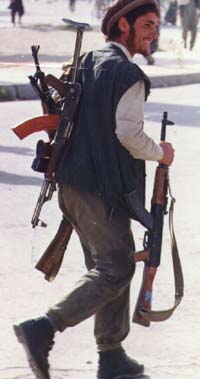The Northern Alliance may supply arms to Taliban
A series of arms seizures in the north indicates that logistical support for the Taleban may be coming from former foes in the so-called Northern Alliance.
By Sayed Yaqub Ibrahimi, IWPR staff reporter in Mazar-e-SharifIn mid-February, Afghan highway police stopped a Toyota Corolla in the northern province of Baghlan. It was loaded with Kalashnikov rifles that police said were destined for the Taleban. Two men were arrested on suspicion of buying the arms for the insurgents in the south.

RAWA: The Northern Alliance commanders still have millions of weapons which they have received from CIA in 80’s through Pakistan ISI.
Over the past few months, anti-government groups in the southern provinces have stepped up their attacks on Afghan army units and police as well as international military forces. Most officials and commentators, including President Hamid Karzai, have said the source of the violence is training camps and bases in Pakistan.
However, a series of arms seizures in the north indicates that logistical support for the Taleban may be coming from an unlikely source: their former foes in the so-called Northern Alliance.
“Our information indicates that whenever Taleban attacks increase in the south, the price of arms goes up in the north,” said General Abdul Khalil, chief of the northern division of the traffic police, commenting on the latest seizures.
Afghanistan’s northern provinces remain the stronghold of factional militia commanders, many of them veterans of the mujahedin wars of the Eighties - who forged a precarious alliance in 1996 to battle the Taleban who had surged out of the south on their way to near-total conquest of the country.
These commanders are now the target of determined attempts at disarmament. Over the past two years, the Afghan government has decommissioned more than 60,000 former combatants and collected over 35,000 weapons under the Disarmament, Demobilisation and Reintegration, DDR, programme. A new effort, the Disarmament of Illegal Armed Groups, DIAG, was launched in June 2005, to collect arms still held by private militias.
Military authorities estimate that there are more than a million weapons in the northern provinces alone. Defence ministry spokesman General Zahir Azimi acknowledges that the army and police don’t know exactly how many weapons remain or where they are located.
“There are armed individuals, and their weapons are not registered with the defence ministry,” he said. “It is possible that these arms are being sent from one place to another.”
While Azimi insisted that the latest disarmament programme was proceeding as planned, local commanders tell a different story.
“I regret handing in my weapons,” said a former commander who spoke on condition of anonymity. “The government plan is just to confiscate arms, but they give nothing in return. Those who have weapons now prefer to sell them rather than just hand them over to the government.”
An official with the national intelligence agency confirmed that a large shipment of weapons, including 35 machine guns and ammunition, was recently seized in Balkh. Two people were arrested but the owner of the weapons escaped.
The official, who asked to remain anonymous, said the intelligence services are continuing their efforts to interdict shipments, since they have information indicating that arms transfers from north to south are increasing.
Political analyst Fazel Rahman Oria warns that the flow of weapons will continue unless the government is willing to take on the commanders - something the Karzai administration has been reluctant to do so far.
In fact, the warlords, many of whom oppose the idea of a strong central authority in Kabul, have little incentive to cooperate with it. They may actually prefer to see the Afghan and international forces preoccupied with curbing the violence in the south.
“If the government cannot or will not deal with the warlords, there is no way to prevent arms transfers from north to the south,” said Oria. “Selling arms to the Taleban is a way of using their weapons. It indicates to the government and to NATO that although they are not able to fire the weapons themselves, they can continue the fight through the Taleban.”
Political analyst Mohammad Hassan Wolesmal agrees that arms sales are a way for the northern commanders to lash out at the government.
“The commanders are under pressure from the government and from the international community to hand in their weapons,” he said. “They are upset about it, and this has an obvious role in strengthening the Taleban. When these commanders sell their weapons to the Taleban, they are making friends with their former enemies.”
Oria said he believes high-level government officials are involved in the weapons transfers.
"Without the involvement of the police and government officials, it would be impossible to shift arms from the north to the south,” he said.
Police deny any official involvement, and insist they are doing all they can to stop the trade.
Interior ministry spokesman Yousuf Stanizai told IWPR that his ministry had not received any intelligence about north-south arms smuggling, and was therefore not taking special measures to interdict shipments.
“We have no information that this is a regular occurrence,” he said. “And we can easily deal with occasional smuggling efforts.”
But police say the smugglers are able to conceal the weapons so skilfully that they have little chance of catching them. A police official who did not want to be named told IWPR that in addition to using the main roads, the smugglers are also sending weapons through the mountains, where the risk of detection and interdiction is low.
[RAWA Homepage] [More reports from Afghanistan] [RAWA Photo Gallery]
http://www.rawa.org